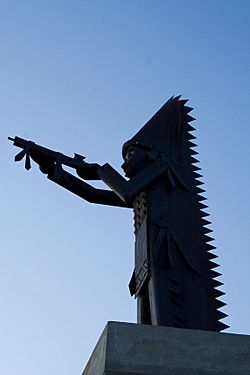War Eagle (Dakota Leader) facts for kids
Quick facts for kids
War Eagle
|
|
|---|---|
| (Dakota: Waŋbdí Okíčhize, or Huya-na ("Little Eagle") | |

War Eagle Monument, Sioux City, IA,
overlooking the Missouri River |
|
| Santee, leader | |
| Personal details | |
| Born | c. 1785 Present day Minnesota or Wisconsin |
| Died | Autumn 1851 Confluence of the Big Sioux and Missouri |
| Spouse | Two wives |
| Children | Daughters, Dawn and Blazing Cloud, married to Theophile Bruguier; two other daughters, three sons |
War Eagle (whose Dakota name was Waŋbdí Okíčhize) was an important leader of the Yankton Sioux Tribe. He was born around 1785 and passed away in the autumn of 1851. He was known for his efforts to bring peace and for his work with both Native American tribes and the United States government.
Contents
War Eagle's Early Life and Journey
Not much is known about War Eagle's very early life. Historians believe he was born around 1785. This was likely in the area that is now Minnesota or Wisconsin.
When he was young, War Eagle left his first tribe, the Santee. He did this to avoid a fight over who would become chief. He wanted to prevent any conflict or bloodshed.
Working with Americans
As a young man, War Eagle spent a lot of time working with white Americans. During the War of 1812, he helped the United States government. He carried important messages for them. He also encouraged Native American groups to support the U.S. against the British.
War Eagle also worked as a guide on the upper Mississippi River. He helped steer riverboats. Later, he became a messenger for the American Fur Company on the Missouri River.
Becoming a Chief and Peacemaker
Around 1830, War Eagle got married in Minnesota. After his marriage, he was welcomed into the Yankton Sioux tribe. He and his wife had four daughters and three sons.
By the mid-1830s, the Yankton Sioux tribe chose him as one of their chiefs. He traveled to Washington, D.C. with other tribal leaders. There, they worked to create peace treaties with the U.S. government.
A Special Gift from the President
War Eagle was very proud of a silver Peace Medal. President Martin Van Buren gave him this medal in 1837. It was a symbol of his commitment to peace and his leadership.
Family and New Settlements
Two of War Eagle's daughters, named Dawn and Blazing Cloud, married a man named Théophile Bruguier. He was a trader with the American Fur Company. Bruguier had also been accepted into the Yankton tribe. He had traveled with them for several years.
One story says that Bruguier told War Eagle about a dream. In his dream, he saw a place where two big rivers met near a tall bluff. War Eagle told Bruguier that he knew this place. He offered to show it to him. Both men had likely seen this spot many times during their fur trading trips. They traveled between St. Louis, Missouri and Fort Pierre, South Dakota.
The First Settlement in Sioux City
Bruguier decided to claim the land where the Big Sioux River and Missouri River joined. In 1849, he built a log cabin there. He and his two wives settled the land. They also traded goods with the Native Americans. His house is considered the first white settlement in what would soon become Sioux City, Iowa.
War Eagle's Final Resting Place
War Eagle passed away in the autumn of 1851. He was buried on top of a tall bluff. This bluff overlooked the meeting point of the Big Sioux and Missouri rivers. Other members of his family are also buried there. This includes his daughters, Dawn and Blazing Cloud.
War Eagle's Lasting Legacy
Today, the bluff where War Eagle is buried is part of War Eagle Park. This park is located in Sioux City, Iowa. A special monument was built there to honor him. It has a steel statue that shows him wearing an eagle feather bonnet. He is also holding a ceremonial pipe. These symbols represent his brave leadership and his dedication to peace.
Some housing projects at the base of the bluff are also named after him. This helps keep his memory alive.
See also
 In Spanish: War Eagle para niños
In Spanish: War Eagle para niños

